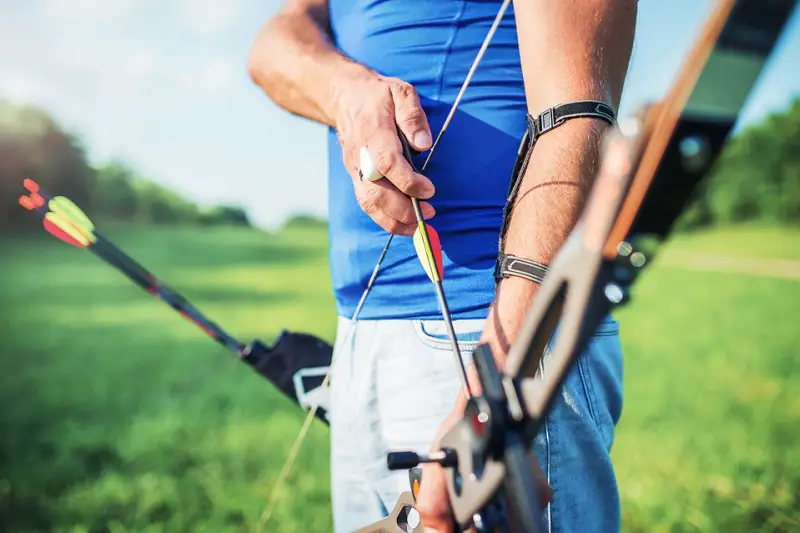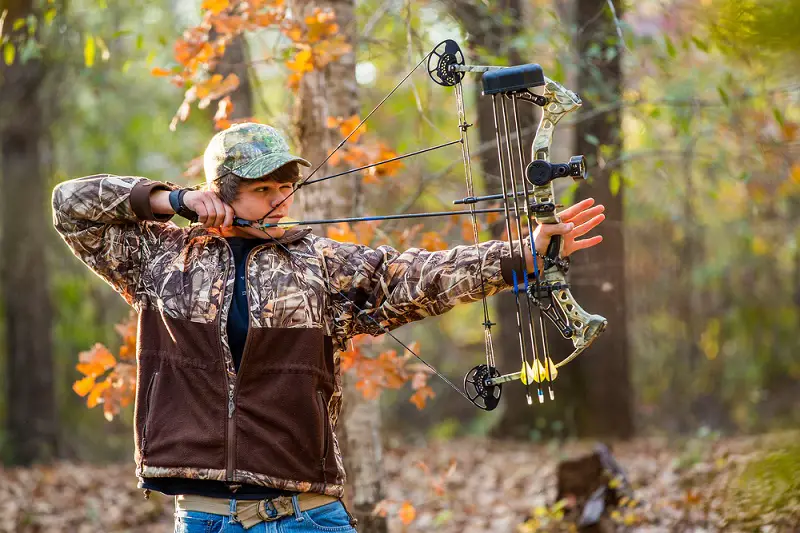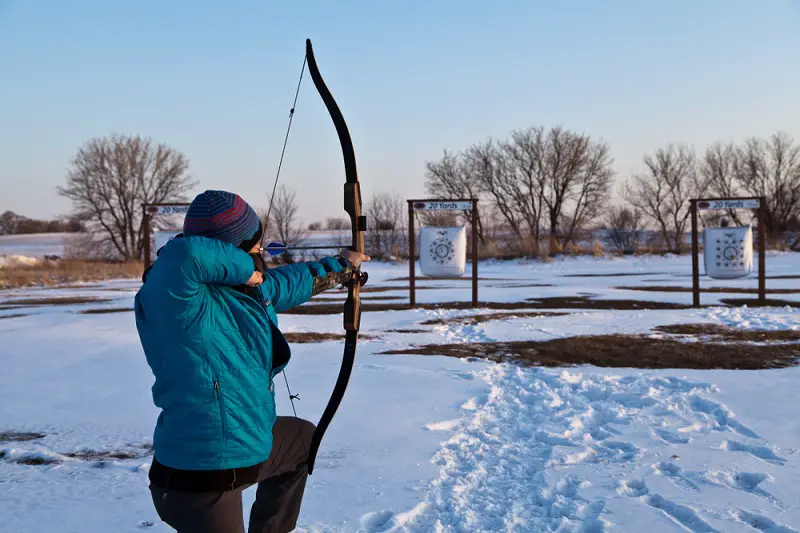
While you’re devouring all the archery info you can find, you’ll probably read a lot about both compound and recurve bows. If you’re a new archer, you might not know much about compound or recurve bows. You might not even be sure what the differences are.
Why is it important to know these bows and their differences? Both have their pros and cons, and one can be much better suited to a particular type of archery. In this guide, we’ll cover the defining characteristics of both bow types, which one you should buy, and much more.
History of Recurve and Compound Bows
Recurve Bow History
Recurve bows have a long history, but no one is exactly sure where they first originated. They did receive mention in ancient texts like the Bible and Homer’s Odyssey.
Recurve bows were weapons of combat and hunting for numerous ancient civilizations, including the Huns, Greeks, and Chinese. In Europe, the recurve bow was popular for some cultures, while other peoples primarily used the longbow. Recurves were also popular with Native Americans across North America, especially on the West Coast.
Recurve bows fell out of use for hunting and implements of war as firearms and more modern weapons became popular. However, bowhunters still use them for a more challenging and traditional bowhunting experience.
Recurves are also popular in competitive and recreational archery with both beginners and professionals. Recurve bows are especially popular with companies that make custom bows because they can manipulate the woods and finishes to create a work of art.
Compound Bow History
Compound bows are a more modern invention than recurve bows. The original compound bows first appeared in the 1960s, created by sawing the ends off recurve bows and fitting them with pulley systems.
These pulleys (known as cams) are the biggest difference between a compound and a recurve bow. They create let-off, which reduces the weight you feel throughout the draw, allowing you to hold only a small portion of the bow’s weight at full draw. This allowed archers to shoot heavier compound bows much easier than heavy recurve bows.
The basic design of compound bows hasn’t changed much since their invention, other than becoming smaller and easier to shoot. Because they’re more compact than their recurve counterparts, they’re a great hunting tool.
As the design evolved, they eventually overtook recurve bows as the preferred bow for most competition archers as well. They’re now more popular than recurve bows — especially in North America.
Popular Uses
Let’s take a look at a few popular uses for both types of bows. While compound bows are certainly more modern and popular, there are plenty of scenarios where a good, old-fashioned recurve can bring a smile to your face.
Recurve Bow Uses
You can use a recurve bow for just about any style of archery or shooting. When it comes to target archery, recurves are excellent for beginners because of their simplicity. Pros also shoot them in World Championships and the Olympics.
Traditional bowhunters still use recurve bows, but the majority of hunters use a compound or crossbow. Conversely, recurve bows are better suited for bowfishing than compound bows because their lack of let-off or a back wall makes them easier to snap shoot.
Compound Bow Uses
Compound bows are the most popular type of bow used in archery today. Their mechanical advantage makes them much easier to learn and become accurate with. Compound bows are the most popular bows used in target archery, especially in 3D archery.
Their small size and ease of use make them deadly accurate for bow hunting. There are even specially made compound bows with extremely high draw weights made for hunting large, exotic animals.
Pros and Cons
Recurve Bow Pros
- With only one string and basically no moving parts, they’re incredibly simple to learn and maintain.
- If you get a takedown bow (a recurve bow that splits into three pieces), they are incredibly easy to transport.
- Some archers find shooting a traditional recurve bow to be more rewarding because it offers the archer less assistance than shooting a compound bow.
Recurve Bow Cons
- When assembled, recurve bows are much longer than a compound bow, making it hard to maneuver through the woods or in a tree stand.
- Recurve bows offer none of the mechanical advantages of a compound bow, making them much harder to shoot accurately.
- There is no let-off with a recurve bow, so even a lighter weight recurve will be much harder to shoot than a 50- or 60-pound compound bow.
- They’re much slower to aim, shoot, and reload than a compound bow.
Compound Bow Pros
- Most people can shoot a compound bow much more accurately than they can shoot a recurve bow.
- Compound bows almost always have the edge when it comes to hunting because of their superior speed, ease of use, and compact size.
- Compound bows are the most popular bow to use for many kinds of target archery, including 3D and indoor target archery.
- A compound bow’s main assets are their mechanical advantage and let-off, making them easier to hold and shoot than recurve bows.
Compound Bow Cons
- There are a lot of different moving parts on the bow itself, all of which have the potential to wear out or break at inopportune times.
- Their complexity also makes them harder to set up and tune because there are so many different factors to consider, especially compared to a simple traditional recurve bow.
- Compound bows have specific draw lengths, which can make it challenging to find one on the used market that fits you.
Things to Know About Compound Bows

The section will point out all of the important considerations that you need to be aware of when looking into compound bows. Be sure to read each section to really familiarize yourself with these points before deciding if a compound bow is right for you.
Draw Lengths and Weights
The biggest thing to know about a compound bow is that they have specific draw lengths and weights, so it’s vital to get a bow that fits your specs. Some bows — especially beginner compound bows — have adjustable draw weights and lengths. You’ll be able to take your best guess and make adjustments after you buy your bow and start shooting.
Pro Tip: When you’re first starting, it’s a good idea to shoot as low of a draw weight as you can. You will be able to shoot longer and more often, helping to refine your technique without getting fatigued, and lessening the chance of getting injured.
Accessories
You’ll need some accessories to set up and start shooting your compound bow. Some necessary accessories include an arrow rest, a bow sight, a peep sight, a D-loop, a release aid, and arrows.
Optional accessories will make shooting easier, like a stabilizer, a wrist sling, string silencers, or a magnified sight lens. Beginner compound bows often come in a package with everything you need to start shooting. But, if you buy a bare bow, you’ll need to purchase and install those accessories before you can shoot.
Maintenance
There is a little bit of maintenance involved when you own and shoot a compound bow. Just before any time you shoot, it’s a good idea to check and make sure none of the screws or bolts on your bow are working themselves loose — it can be hard to find replacements if one of them falls out and disappears.
Bow strings also need maintenance. Your bow string will look fuzzy after a few weeks of shooting, which you can fix by applying some bow string wax to it. It will also need replacing when it gets worn out or frayed.
Things to Know About Recurve Bows

This section will outline all of the considerations you need to keep in mind when considering a recurve bow. Be sure to give some thought to each section to decide if a recurve bow might be for you.
Bow Length
One of the most important things to know about recurve bows is that there are different lengths, similar to how compound bows have different set draw lengths. In general, the longer your draw length is, the longer your bow should be. Longer bows will be much more comfortable to shoot for long draw length archers.
There are exceptions to this rule. Many traditional recurve archers will shoot a shorter recurve bow for hunting because the benefit of a compact bow in the woods outweighs a short bow being a little uncomfortable to draw and shoot.
Different Types of Recurve Bows
There are different types of recurve bows. One popular type of recurve bow is a traditional, all-wood, one-piece recurve bow. These bows are thousands of years old and still preferred by some traditional archers for their simplicity.
Takedown recurve bows are becoming more popular. They disassemble into three pieces: a riser and two bow limbs. You’ll be able to transport your bow easily and mix-and-match risers and limbs to customize the draw weight and length of your bow.
Modern target recurves feature risers and limbs made from materials like carbon fiber, fiberglass, aluminum, bamboo, and other composite materials.
Accessories
You need to be aware of the accessories you need to set up and shoot your recurve. Some simpler traditional recurve bows do not need any accessories at all. You can shoot with the arrow resting on your hand. All you need are some arrows and you’re good to go.
However, most modern recurve bows will require a simple arrow rest. Modern target recurve bows will usually also have a bow sight, a set of multiple stabilizers, a finger tab to protect your fingers, string silencers, and a clicker to signal when to shoot your arrow.
Which Should You Choose?
There are many different kinds of archery, and the types you plan on participating in will greatly impact which bow type will suit you best. This section will cover a few different common archery scenarios and discuss which bow type would best suit the situation.
Beginner Hunting
The first hunting scenario we want to cover concerns a brand-new beginner that has never shot a bow before. Someone in this situation will have a lot to learn, so a bow that is easy to learn and shoot with will be a huge benefit. A beginner’s compound bow will be best in this situation.
Compound bows have a much flatter learning curve than a recurve bow, and you can buy nearly any compound bow in a complete package at a bow shop. From there, it won’t take a beginner very long to become accurate enough to hunt common animals like deer.
Experienced Hunting
What if you’re a more experienced bow hunter or just looking for a challenge? Hunting with a traditional recurve bow is perfect for you.
It takes an extreme amount of dedication and effort to become accurate with a recurve bow because it has none of a compound bow’s mechanical advantages. Recurves don’t benefit from the helpful accessories like a bow sight or stabilizer.
Sometimes they don’t even have an arrow rest. However, the effort will pay off when you manage to harvest your first animal with essentially nothing but a stick and string.
Bowfishing
Fish are fast, so bowfishing requires snap shooting. Snap shooting is the act of drawing and shooting your bow very quickly, usually before your target gets away.
The back wall and let-off on a compound bow actually work against you in this situation, and a recurve bow will snap shoot better.
Target Archery
If you want to shoot for fun, a recurve bow is the perfect simple bow for beginners. They’re easy to learn, their simple design makes them durable, and since they have no specific draw length, multiple archers can share one.
If you enjoy shooting and decide you want to compete at higher levels, there are high-level competitions for both simple traditional recurve bows as well as fully decked-out target recurve bows.
When it comes to 3D archery, where archers score points by shooting at three-dimensional foam animals, compound classes are fiercely competitive. If you’re the kind of person that thrives on tight competitions and intense pressure, compound target archery is the perfect type of archery for you.
There can even be a bit of money on the table at the higher levels. Some large archery tournaments and sponsors will pay out tens of thousands of dollars for a win.
Final Thoughts
That wraps up our comparison of recurve bows and compound bows. If you’re looking to buy your first bow and get started in archery, we hope we’ve given you enough information to make the best choice.
For more archery information, be sure to check out our other informative articles and buyers guides.
